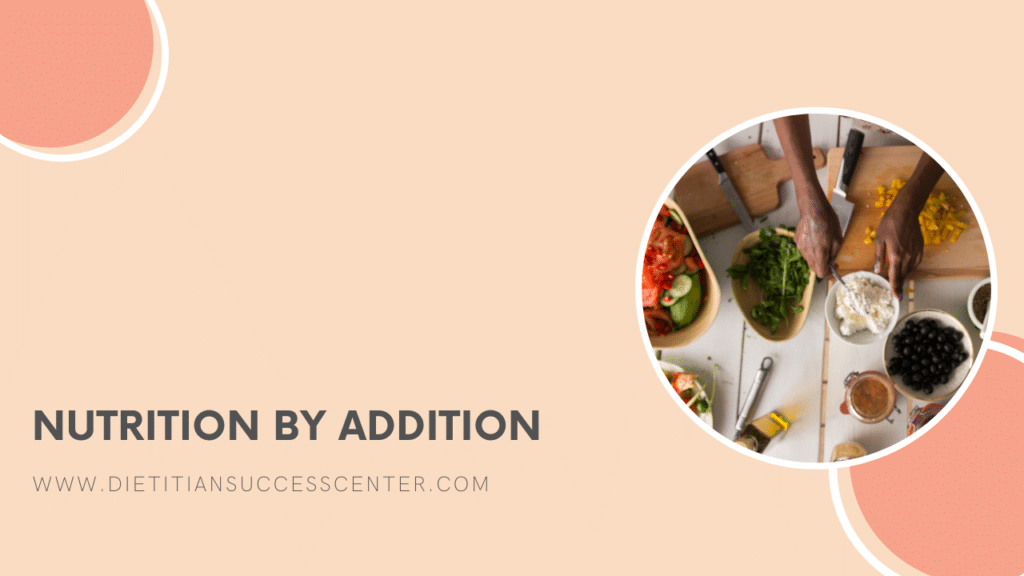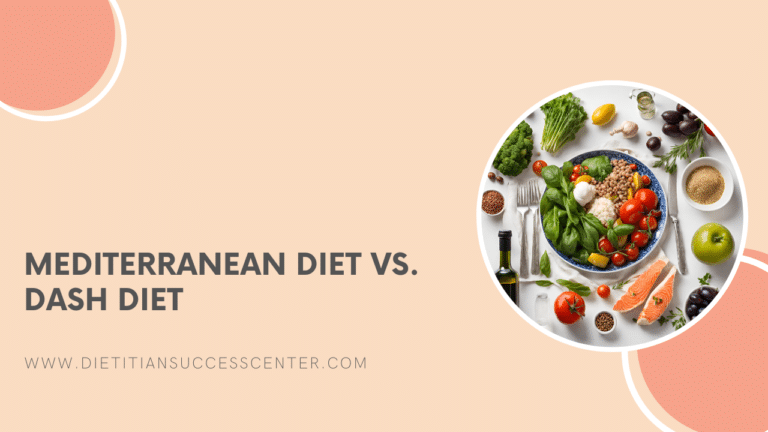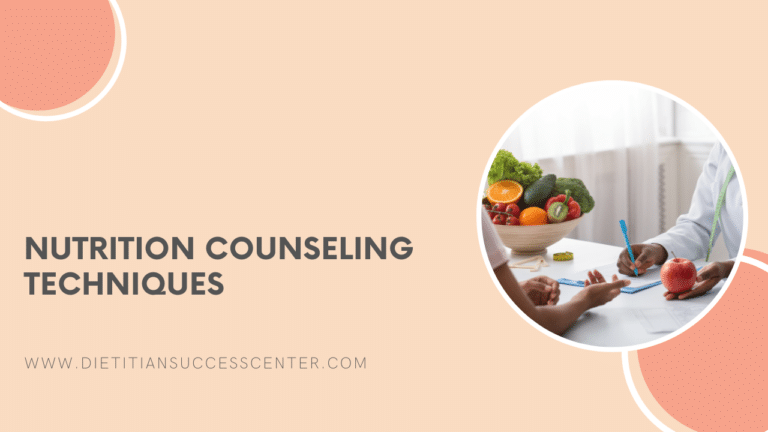

Written by Olivia Farrow, RD, MHSc
Reviewed by Maria Dellanina, RDN
In this article, we’ll explore the concept of nutrition by addition and provide you with practical ideas to integrate this approach into your practice.
What is Nutrition by Addition?
Rather than focusing on restrictive measures or eliminating certain foods, nutrition by addition means enhancing meals by incorporating nutrient-dense options.
Instead of fixating on what to eliminate, this approach encourages adding wholesome options to enhance the overall nutritional value of the diet.
By incorporating nutrient-dense foods into regular food choices, rather than restricting them, it fosters a balanced and sustainable approach to nutrition.
Nutrition by addition allows for flexibility and enjoyment in eating while reaping the benefits of a nourishing diet. This flexibility fosters a positive relationship with food, reducing the likelihood of feelings of deprivation or guilt often associated with restrictive diets.
Clients are more likely to adopt and maintain positive dietary changes when they feel a sense of abundance rather than scarcity.
This sustainability is crucial for achieving and maintaining long-term health goals, as it fosters a positive and enduring relationship with food, encouraging clients to view nutrition as a lifelong journey rather than a short-term fix.
Incorporate Nutrition by Addition into your Practice
If you want to start incorporating a nutrition by addition approach into your practice, consider these steps:
-
- Assess Readiness for Change: Take a moment to understand and evaluate your client’s health goals, and desire and readiness for change.
-
- Assess Client Needs: Evaluate your client’s current dietary habits and nutritional goals. Identify areas where they could benefit from adding more nutrient-rich foods to their diet.
-
- Set Realistic Goals: Start small and focus on gradual changes. Work with your client to set SMART goals to add one or two nutritious foods to each meal or snack.
-
- Educate and Empower: Share the concept of nutrition by addition with your clients in a clear and accessible manner. Consider also incorporating education on balanced meals and snacks and the benefits of eating regular meals and snacks at consistent times.
-
- Provide Practical Guidance: Offer practical tips and suggestions for incorporating nutrient-dense foods into daily meals and snacks. Provide recipe ideas, cooking techniques, and meal planning strategies to help clients implement these changes effectively.
Getting Started
After walking through the steps above, consider encouraging your client to ask themselves the following questions to incorporate nutrition by addition into their diet:
-
- When do I eat? Should I add a meal or snack?
-
- This is an opportunity to provide education on regular, consistent mealtimes.
-
- When do I eat? Should I add a meal or snack?
-
- What do I eat?
-
- This is an opportunity to provide education on a balanced plate, and the importance of certain macro or micronutrients that your client could benefit from incorporating.
-
- What do I eat?
-
- What else can I add?
- What else can I add?
-
- This is an opportunity to ask your client about what fruits, vegetables, herbs, spices, etc. they enjoy and suggest adding these and other options your client might benefit from incorporating.
Nutrition by Addition Examples
The examples you provide your client will depend on their unique diet, intake patterns, and nutritional opportunities.
One way you can explain nutrition by addition is by recommending certain foods that could be incorporated (e.g. flax seeds, if your client could benefit from more fiber), then provide several ideas of where to incorporate them (e.g. yogurt, cereal, smoothies, salads).
If your client often experiences cravings for certain foods that lack important nutrients their body needs, you could suggest some nutritious foods that they could eat alongside the meal or snack to make it more satiating and nutrient dense.
These are the methods that we have incorporated into our new handout, included in our FREE Nutrition Client Resource Kit.

Finally, for clients who have a typical meal routine that could benefit from some added macro and micronutrients, you could suggest some ways to make their meal or snack more nutrient dense, flavorful, and satisfying, such as the examples below:
Plain Yogurt
-
- Add: Sliced bananas + a sprinkle of chia seeds.
-
- Add: Diced apples + a sprinkle of cinnamon.
-
- Add: Mixed berries + a handful of almonds.
Toast
-
- Add: Sliced strawberries + peanut butter + a sprinkle of flaxseeds.
-
- Add: Sliced cucumber + a small handful of spinach + a spread of hummus.
-
- Add: Mashed avocado + sliced tomato + balsamic vinegar
Oatmeal
-
- Add: Sliced bananas + a handful of walnuts + a dash of cinnamon.
-
- Add: Diced apples + a dollop of Greek yogurt + a drizzle of maple syrup.
-
- Add: Mixed berries + a sprinkle of almonds + a drizzle of almond butter.
Rice
-
- Add: Stir-fried mixed vegetables (such as bell peppers, broccoli, and carrots) + grilled tofu or chicken + kimchi
-
- Add: Sauteed spinach and mushrooms + cooked chickpeas + a sprinkle of nutritional yeast
-
- Add: Roasted sweet potato + black beans + a squeeze of lime juice
Plain Salad
-
- Add: Grilled chicken + sliced cucumbers
-
- Add: Quinoa + chickpeas + cherry tomatoes
-
- Add: Hard-boiled eggs + sliced almonds + pomegranate arils
Plain Pasta/Noodles
-
- Add: Sauteed garlic, cherry tomatoes, and spinach + cooked chicken or tofu + a drizzle of olive oil and a sprinkle of red pepper flakes
-
- Add: Steamed frozen mixed vegetables + cooked lentils or beans + a dollop of pesto
- Add: Bok choy and carrots + boiled egg + a sprinkle of green onions
In summary, nutrition by addition stands out as a client-centered approach that not only enhances nutritional intake, but also promotes positive attitudes towards food. By steering away from restrictive measures, you can empower your clients to make sustainable changes that contribute to overall health and well-being, fostering a balanced and joyful approach to nutrition.
Disclaimer: the information provided in all written materials is for educational purposes only and is not to be used as medical advice or to diagnose or treat a medical disease. It is strictly for informational purposes and is general in nature. Dietitian Success Center Inc. is not responsible and cannot be held liable for any actions or inactions taken related to the information produced. Consult with your local medical provider before implementing any dietary changes. It is hereby understood that the information provided does not replace medical advice provided by your healthcare provider.








